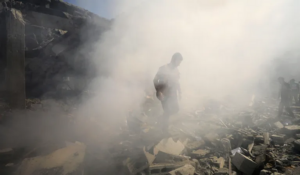Annexation, expulsion and Israeli settlements: Netanyahu gears up for next phase of Gaza war

A Palestinian inspecting the site of an Israeli strike in the northern Gaza Strip, September 2023
Aluf Benn writes in Haaretz on 9 September 2024:
Israel is entering the second phase of its war in Gaza, when it will strive to complete its takeover of the northern Gaza Strip from the previous border to the Netzarim corridor. We can predict that this area will then gradually be made available for Jewish settlement and annexation to Israel, according to the degree of international outcry that such steps might incur.
If that happens, Palestinian residents who remain in northern Gaza will be expelled, as suggested by Maj. Gen. (res.) Giora Eiland, under threat of starvation and under cover of “protecting their lives” while the Israeli military hunts down Hamas militants in that sector.
Prime Minister Benjamin Netanyahu must be dreaming about what his supporters will see as a lifetime achievement: Expanding Israel’s territory for the first time after 50 years of withdrawal, beginning with the disengagement agreements after the Yom Kippur War. Most of his predecessors, as well as he himself, gave up territory, and now the time has come for reversing that trend and for expansion. This will be his “total victory,” his “Zionist response” to the October 7 massacre, to the abductions, the terrible humiliation of Israel and its military by the Palestinians and Lebanese.
In this right-wing Israeli government’s vision, which it no longer really bothers to conceal, the Palestinians in northern Gaza will face the fate of the Armenians in Nagorno-Karabakh: They were expelled from the region a year ago, overnight, in a rapid move by Azerbaijani President Ilham Aliyev, Israel’s close ally.
“The world” saw this and moved on: 100,000 refugees are still stranded in Armenia, which is in no rush to integrate them. Similarly, the expelled residents of northern Gaza will huddle together with refugees from the first phase of the war in the “humanitarian enclave” in the south.
This entry into the new phase of the war did not begin with a multidivisional maneuver or some daring raid into the enemy’s heartland. Instead, it came via a bureaucratic statement on August 28, announcing the appointment of Col. Elad Goren as head of the humanitarian-civil effort in Gaza with the Coordinator of Government Activities in the Territories unit.
This lengthy title, a burden Goren will bear until a proper military acronym is found, is equivalent to the Civil Administration chief in the West Bank – and should properly be referred to as “governor of Gaza.” He is a contemporary reincarnation of Maj. Gen. Moshe Goren, who served in this capacity following the occupation of Gaza in 1967’s Six-Day War.
The next step was Netanyahu’s instruction to the army last week to prepare to distribute humanitarian aid in Gaza, replacing the international organizations. Israel Defense Forces Chief of Staff Lt. Gen. Herzl Halevi demurred, warning of danger to soldiers and of heavy costs. However, as far as is known, Netanyahu remained unconvinced and is standing his ground.
The motive is obvious: whoever distributes the food and medicine has their hand on the power switch. Along the way, Israel will have the opportunity to once and for all remove from Gaza the UN Relief and Works Agency for Palestinian refugees – seen by the right as an anti-Zionist project.
In the meantime, Hamas will go on ruling the area between the Netzarim corridor and the Philadelphi route in the south, surrounded and besieged by Israel, which will now take control of aid distribution.
This is the meaning of Netanyahu’s statement that the border between Gaza and Egypt (the Philadelphi route) will remain under Israeli control. In such a situation, Netanyahu and his partners hope that after another winter in tents and without basic facilities, the 2 million Palestinians crowded in Rafah, Khan Yunis and Al-Mawasi will realize that they cannot go back to their ruined homes. Accordingly, despair is supposed to incite them against Yahya Sinwar’s oppressive rule – and to encourage many of them to leave Gaza altogether.
Netanyahu’s relinquishment of the return of the Israeli hostages, and his decision to ignore the majority position in the public and abandon them to terrible torture and death in Hamas’ tunnels, is intended to turn the tables on Sinwar: Rather than them being an asset and leverage for significant concessions from Israel, the hostages will become a burden on the Palestinians, as well as Israel’s justification for continued warfare, siege and occupation.
This is how Israel enters the second phase of its war against Hamas.
This article is reproduced in its entirety
